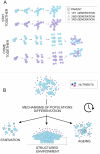Aspects of Multicellularity in Saccharomyces cerevisiae Yeast: A Review of Evolutionary and Physiological Mechanisms
- PMID: 32599749
- PMCID: PMC7349301
- DOI: 10.3390/genes11060690
Aspects of Multicellularity in Saccharomyces cerevisiae Yeast: A Review of Evolutionary and Physiological Mechanisms
Abstract
The evolutionary transition from single-celled to multicellular growth is a classic and intriguing problem in biology. Saccharomyces cerevisiae is a useful model to study questions regarding cell aggregation, heterogeneity and cooperation. In this review, we discuss scenarios of group formation and how this promotes facultative multicellularity in S. cerevisiae. We first describe proximate mechanisms leading to aggregation. These mechanisms include staying together and coming together, and can lead to group heterogeneity. Heterogeneity is promoted by nutrient limitation, structured environments and aging. We then characterize the evolutionary benefits and costs of facultative multicellularity in yeast. We summarize current knowledge and focus on the newest state-of-the-art discoveries that will fuel future research programmes aiming to understand facultative microbial multicellularity.
Keywords: AMN1 gene; adaptation; aging; cell differentiation; cell specialization; cooperation; evolution; facultative multicellularity; metabolic cooperation; spatial structure; starvation; yeast exometabolome.
Conflict of interest statement
The authors declare no conflict of interest.
Figures

References
-
- Grosberg R.K., Strathmann R.R. The evolution of multicellularity: A minor major transition? Annu. Rev. Ecol. Evol. Syst. 2007;38:621–654. doi: 10.1146/annurev.ecolsys.36.102403.114735. - DOI
-
- Knoll A.H. The multiple origins of complex multicellularity. Annu. Rev. Earth Planet Sci. 2011;39:217–239. doi: 10.1146/annurev.earth.031208.100209. - DOI
Publication types
MeSH terms
LinkOut - more resources
Full Text Sources
Molecular Biology Databases

